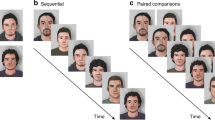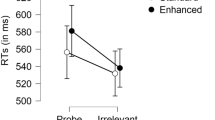Abstract
Eyewitnesses often have to recognize the perpetrators of an observed crime from identity lineups. In the construction of these lineups, a decision must be made concerning where a suspect should be placed, but whether location in a lineup affects the identification of a perpetrator has received little attention. This study explored this problem with a face-matching task, in which observers decided if pairs of faces depict the same person or two different people (Experiment 1), and with a lineup task in which the presence of a target had to be detected in an identity parade of five faces (Experiment 2). In addition, this study also explored if high accuracy is related to a perceptual pop-out effect, whereby the target is detected rapidly among the lineup. In both experiments, observers’ eye movements revealed that location determines the order in which people were viewed, whereby faces on the left side were consistently viewed first. This location effect was reflected also in observers’ responses, so that a foil face on the left side of a lineup display was more likely to be misidentified as the target. However, identification accuracy was not related to a pop-out effect. The implications of these findings are discussed.





Similar content being viewed by others
References
Bindemann M (2010) Scene and screen center bias early eye movements in scene viewing. Vis Res 50:2577–2587
Bindemann M, Scheepers C, Ferguson HJ, Burton AM (2010) Face, body and centre of gravity mediate person detection in natural scenes. J Exp Psychol: Human Percept Perform 36:1477–1485
Blais C, Jack RE, Scheepers C, Fiset D, Caldara R (2008) Culture shapes how we look at faces. PLoS One 3(8):e3022
Brewer N, Palmer MA (2010) Eyewitness identification tests. Leg Criminol Psychol 15:77–96
Brewer N, Gordon M, Bond N (2000) Effect of photoarray exposure duration on eyewitness identification accuracy and processing strategy. Psychol Crime Law 6:21–32
Bruce V, Henderson Z, Greenwood K, Hancock PJB, Burton AM, Miller P (1999) Verification of face identities from images captured on video. J Exp Psychol: Appl 5:339–360
Burt DM, Perrett DI (1997) Perceptual asymmetries in judgements of facial attractiveness, age, gender, speech and expression. Neuropsychologia 35:685–693
Burton AM, White D, McNeill A (2010) The Glasgow face matching test. Behav Res Method 42:286–291
Butler SH, Harvey M (2005) Does inversion abolish the left chimeric face processing advantage? Neuroreport 16:1991–1993
Clark SE, Davey SL (2005) The target-to-foils shift in simultaneous and sequential lineups. Law Human Behav 29:151–172
Clark SE, Howell RT, Davey SL (2008) Regularities in eyewitness identification. Law Human Behav 32:187–218
Coolican J, Eskes GA, McMullen PA, Lecky E (2008) Perceptual biases in processing facial identity and emotion. Brain Cogn 66:176–187
Costigan R (2007) Identification from CCTV: the risk of injustice. Criminal Law Review, 591-608.
Dunning D, Perretta S (2002) Automaticity and eyewitness accuracy: a 10 to 12 second rule for distinguishing accurate from inaccurate positive identification. J Appl Psychol 87:951–962
Dunning D, Stern LB (1994) Distinguishing accurate from inaccurate eyewitness identifications via inquiries about decision processes. J Personal Soc Psychol 67:818–835
Ericsson KA, Simon HA (1980) Verbal reports as data. Psychol Rev 87:215–251
Frowd CD, Hancock PJB, Bruce V, Skelton FC, Atherton C et al (2011) Catching more offenders with EvoFIT facial composites: lab research and police field trials. Global J Human Social Sci 11:46–58
Gibson SJ, Solomon CJ, Maylin MIS, Clark C (2009) New methodology in facial composite construction: from theory to practice. Intern J Electron Secur Digit Forensic 2:156–168
Gilbert C, Bakan P (1973) Visual asymmetry in perception of faces. Neuropsychologia 11:355–362
Haxby JV, Hoffman EA, Gobbini MI (2000) The distributed human neural system for face perception. Trend Cogn Sci 4(6):223–233
Heath RL, Rouhana A, Ghanem DA (2005) Asymmetric bias in perception of facial affect among roman and Arabic script readers. Laterality 10:51–64
Henderson JM, Williams CC, Falk RJ (2005) Eye movements are functional during face learning. Mem Cognit 33:98–106
Hershler O, Hochstein S (2005) At first sight: a high-level pop out effect for faces. Vis Res 45:1707–1724
Hsiao JH, Cottrell G (2008) Two fixations suffice in face recognition. Psychol Sci 19:998–1006
Hsiao JH, Cottrell GW (2009) Not all visual expertise is holistic, but it may be leftist: the case of Chinese character recognition. Psychol Sci 20:455–463
Hurlburt RT, Heavey CL (2001) Telling what we know: describing inner experience. Trend Cogn Sci 5:400–403
Innocence Project (n.d.). Retrieved October 29, 2011, from Innocence Project Website: http://www.innocenceproject.org/
Jenkins R, Burton AM (2008) Limitations in facial identification. Justice Peace 172:4–6
Kneller W, Memon A, Stevenage S (2001) Simultaneous and sequential lineups: decision processes of accurate and inaccurate witnesses. Appl Cogn Psychol 15:659–671
Leach AM, Cutler BL, Wallendael LV (2009) Lineups and eyewitness identification. Annu Rev Law Social Sci 5:157–178
Leonards U, Scott-Samuel NE (2005) Idiosyncratic initiation of saccadic face exploration in humans. Vis Res 45:2677–2684
Lindsay PH, Norman DA (1977) Human information processing, 2nd edn. Academic Press, New York
Mansour JK & Flowe HD (2010) Eyetracking and eyewitness memory. Forensic Update, No. 101.
Mansour JK, Lindsay RCL, Brewer N, Munhall KG (2009) Characterizing visual behaviour in a lineup task. Appl Cogn Psychol 23:1012–1026
Megreya AM, Bindemann M (2009) Revisiting the processing of internal and external features of unfamiliar faces: the head-scarf effect. Perception 38:1831–1848
Megreya AM, Burton AM (2006a) Recognising faces seen alone or with others: when two heads are worse than one. Appl Cogn Psychol 20:957–972
Megreya AM, Burton AM (2006b) Unfamiliar faces are not faces: evidence from a matching task. Mem Cognit 34:865–876
Megreya AM, Burton AM (2007) Hits and false positives in face matching: a familiarity based dissociation. Percept Psychophys 69:1175–1184
Megreya AM, Burton AM (2008) Matching faces to photographs: poor performance in eyewitness memory (without the memory). J Exp Psychol: Appl 14:364–372
Megreya A, Havard C (2011) Left face matching bias: right hemisphere dominance or scanning habits. Lateral: Asymmetries Body, Brain Cogn 16:75–92
Meisner CA, Brigham JC (2001) Thirty years of investigating the own-race bias in memory for faces: a meta-analytic review. Psychol Publ Policy Law 7:3–35
Memon A, Vrij A, Bull R (2003) Psychology & law: truthfulness, accuracy and credibility of victims, witnesses and suspects. Wiley, Chichester
Mertens I, Siegmund H, Grusser OJ (1993) Gaze motor asymmetries in the perception of faces during a memory task. Neuropsychologia 31:989–998
Nisbett RE, Wilson TD (1977) Telling more than we can know: verbal reports on mental processes. Psychol Rev 84:231–259
Rayner K (1998) Eye movements in reading and information processing: 20 years of research. Psychol Bull 124:372–422
Rhodes G (1985) Lateralized processes in face recognition. Br J Psychol 76:249–271
Ross DF, Benton TR, McDonnell S, Metzger R, Silver C (2007) When accurate and inaccurate eyewitnesses look the same: a limitation of the ‘pop-out’ effect and the 10- to 12-second rule. Appl Cogn Psychol 21:677–690
Sakhuja T, Gupta GC, Singh M, Vaid J (1996) Reading habits affect asymmetries in facial affect judgements: a replication. Brain Cogn 32:162–164
Sauerland M, Sporer SL (2007) Post-decision confidence, decision time, and self-reported decision processes as postdictors of identification accuracy. Psychol Crime Law 13:611–625
Schwarzer G, Huber S, Dümmler T (2005) Gaze behavior in analytical and holistic face processing. Mem Cognit 33:344–354
Shapiro P, Penrod S (1986) A meta-analysis of facial identification studies. Psychol Bull 100:139–156
Spalek TM, Hammad S (2005) The left-to-right bias in inhibition of return is due to the direction of reading. Psychol Sci 16:15–18
Treisman AM, Gelade G (1980) A feature-integration theory of attention. Cogn Psychol 12:97–136
Vaid J, Singh M (1989) Asymmetries in the perception of facial affect: is there an influence of reading habits? Neuropsychologia 27:1277–1287
Wells GL, Small M, Penrod S, Malpass RS, Fulero SM, Brimacombe CAE (1998) Eyewitness identification procedures: recommendations for lineups and photospreads. Law Human Behav 22:1–39
Wells GL, Memon A, Penrod SD (2006) Eyewitness evidence: improving its probative value. Psychol Sci Public Interest 7:45–75
Yovel G, Tambini A, Brandman T (2008) The asymmetry of the fusiform face area is a stable individual characteristic that underlies the left-visual-field superiority for faces. Neuropsychologia 46:3061–3068
Author information
Authors and Affiliations
Corresponding author
Rights and permissions
About this article
Cite this article
Megreya, A.M., Bindemann, M., Havard, C. et al. Identity-Lineup Location Influences Target Selection: Evidence from Eye Movements. J Police Crim Psych 27, 167–178 (2012). https://doi.org/10.1007/s11896-011-9098-7
Published:
Issue Date:
DOI: https://doi.org/10.1007/s11896-011-9098-7




